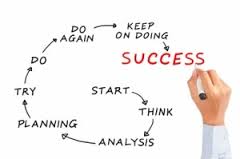Category Archives: Boosting Creativity, Productivity & Effectiveness
Bringing Life to Work
I’m delighted to announce that my book, The Pinocchio Principle: Becoming a Real Leader is now available as an ebook on the Amazon Kindle store! Today’s post on bringing life back into work is an excerpt from the Preface. I hope you enjoy it.
The Pinocchio Principle: Becoming a Real Leader
Preface
I have always been amazed by the number of people who seem to think of work as something of a necessary evil — simply what must be done in order to earn a paycheck. For so many who toil through their workday, the primary goal is to make it to the weekend so they can really live. Going through the motions, working side by side with others whose hearts and minds they seldom truly connect with, they withhold the very parts of themselves that make them come alive.
 For some it wasn’t always this way. Many began their careers ignited with passion and optimism, only to find that their flames began to flicker as they encountered obstacle after obstacle that kept them from achieving what they believed would be success. Succumbing to the unwritten rules of the organizations and other environments they found themselves in, which suggested they needed to act or think in a certain way to get ahead, they may have slowly sold out on their dreams and relegated themselves to quiet complacency.
For some it wasn’t always this way. Many began their careers ignited with passion and optimism, only to find that their flames began to flicker as they encountered obstacle after obstacle that kept them from achieving what they believed would be success. Succumbing to the unwritten rules of the organizations and other environments they found themselves in, which suggested they needed to act or think in a certain way to get ahead, they may have slowly sold out on their dreams and relegated themselves to quiet complacency.
Many of us were not brought up to expect that work would be fun or gratifying in any way – nor should it be. That’s why they call it work, we may have been told. As a result, we may have never really expected much from our careers or professional lives. And as the saying goes, life has a way of living up to our expectations. In just about every corporation, nonprofit or other organization, you will find people in jobs that do not ignite their talents and passions. Some remain dormant in those jobs because they fear that if they pursue their hearts’ desires, they won’t be able to put food on their tables. Many don’t realize that there might be a better alternative.
Most of us have learned how to turn ourselves on and off at will, in an effort to spare ourselves the pain of disappointment or frustration — or to maintain what we have come to believe is a professional demeanor. It is not uncommon to hear people say that they are very different at work than they are at home. Those golden parts of ourselves that we think we are protecting suffer when we do not let them breathe and interact in the very realms that provide us opportunities to learn more about who we are and what we are here to do in the world. We miss the chance to become a part of something greater than ourselves. And the organizations and communities we are a part of miss out on the unique contribution each of us has the potential to make.
We can no longer afford to fragment ourselves in this way, denying the fulfillment of our secret dreams and downplaying the insights we have about what we can do to make life better — for ourselves, and everyone around us. As more and more of us feel the pain that accompanies the denial of our spirits, we start to realize that the time has come for us to bring the totality of who we are to what we do, no matter our vocation, title or role.
For, in the end, it is impossible to have a great life unless it is a meaningful life. And it is very difficult to have a meaningful life without meaningful work.
~ Jim Collins, American business consultant, author and lecturer
We are beginning to awaken to our unique calls to service, creativity and innovation. As we find ways to unleash our distinctive talents and passions at work, we will significantly increase the quality of our own lives, as well as the lives of everyone around us. Corporations that take steps to create environments that allow people to thrive will be met with rich rewards as ingenuity pours forth in ways that lead to increased profit and market share, as well as the creation of self-sustaining cultures that inspire people to sustain success by doing what they do best.
There are people among us who have the ability to snap us out of our trances — our states of quiet desperation —and help us bring more of who we truly are to everything that we do.
They can do this for others because they have done it for themselves.
They are called leaders.
You may be one of them. The Pinocchio Principle is dedicated to allowing you to play a bigger, more significant and meaningful part in the world by unearthing your own leadership in ways that bring about a greater good — and showing others the way to rise through your own example.
I hope you enjoy reading it as much as I have enjoyed writing it.
“It is never too late to be what you might have been.”
~ George Eliot, English novelist, 1819-1880
 Click here to look inside and preview more or to order your ebook version of The Pinocchio Principle: Becoming a Real Leader for Kindle. Don’t have a Kindle? No worries. Anybody can read Kindle books—even without a Kindle device—with the FREE Kindle app for smartphones and tablets.
Click here to look inside and preview more or to order your ebook version of The Pinocchio Principle: Becoming a Real Leader for Kindle. Don’t have a Kindle? No worries. Anybody can read Kindle books—even without a Kindle device—with the FREE Kindle app for smartphones and tablets.
Help me spread the word! Please pass this news on to anyone you think might benefit.
Image courtesy of Danilo Rizzuti at FreeDigitalPhotos.net
How to Stay Confident Around People Who Intimidate You
 In my last post Do Some People Intimidate You?, I wrote about the phenomenon that grips most of us at one time or another, leading us to feel inadequate, uneasy and temporarily inept in the presence of certain people. As I wrote in that article, through there are a number of circumstances that can trigger it, the root of all intimidation lies in what you are believing about yourself in any given moment. This leads us to question,
In my last post Do Some People Intimidate You?, I wrote about the phenomenon that grips most of us at one time or another, leading us to feel inadequate, uneasy and temporarily inept in the presence of certain people. As I wrote in that article, through there are a number of circumstances that can trigger it, the root of all intimidation lies in what you are believing about yourself in any given moment. This leads us to question,
What can you do about it when it happens?
And better yet, how can you prevent it altogether?
Well, the interesting thing about intimidation is that the root of it is also the remedy. When you find yourself going down Intimidation Street, you can stop and redirect yourself down a more positive path simply by becoming aware of and eventually changing your thoughts.
I admit that this is much easier said than done. However, as with so many things in life, it gets better and better with practice. Here are three ways to redirect your negative thoughts about yourself to something more positive:
(1) Think of someone in your life in whose presence you feel really good about yourself – someone who leads you to believe you could do anything. Go ahead and try it right now. See if you can place yourself in that person’s presence and feel the way you do when you are together. You might find that you are sitting up straighter and holding your head higher just at the thought. Know that when you are with that person, you are the same you that you are when you are with people who intimidate you. See if you can envision being in the presence of someone who intimidates you while you are feeling the way you feel when you are around someone you feel loved and admired by. Imagine how much easier it would be to interact with others while you are in this state. Practice this in your mind often.
The next time you are around someone who intimidates you, use the exact same process. Treat every interaction as an opportunity to build this muscle for yourself. And before you know it, you will find that your behavior will become more consistently confident and self assured. You may also notice that the things that used to send you into a tailspin no longer really bother you.
(2) The next time you find yourself feeling intimidated, notice what you are believing. Then ask yourself if it is really true. This may be difficult to do when you are standing in front of someone, so if it’s easier you can wait until the moment has passed. You may find when you reflect on the situation that you felt the way you did when you were a kid and realize that those feelings are no longer relevant. You may be believing that there is something you need to do or be to win someone’s affection or approval when in reality you just need to relax and be yourself and let go of needing so much to be liked by others. You may be believing that the other person is thinking something negative about you that is purely conjecture you are poisoning your mind with.
When you notice and begin to challenge your assumptions, they lose their hold on you. It’s kind of like being in a haunted house after the lights have been switched on. You can go back there when it’s dark again, but it’ll never scare you the way it might have before.
(3) See if you can shift your focus from what you think you need to what you can give. As I mentioned before, we get intimidated when we feel we are lacking in some way. And then we tend to act in ways that will allow us to get what we think we need to feel better. Often that comes in the form of someone’s approval or affection. Think of what kinds of things you think you need from others in order to feel more confident. Is it a smile? Is it a compliment? Is it someone paying attention to you? A little appreciation or support?
See if you can find a way to give to someone whatever you believe you need. And do it in such a way that you are not expecting anything in return other than to be of service to another human being. In other words, don’t give to get. Give because it makes you feel good. When you do this, you will find yourself reconnected with the reserves that you are most in need of. Because when you give something – even if it is something you think you don’t have – you realize that by the very nature of giving it to others, you become an abundant supply.
“Those who bring sunshine to others cannot keep it from themselves.” – Anonymous
If you would like to learn more about building confidence, being authentic, and moving beyond old patterns that keep you from fully enjoying your life, check out my new video program, On the Road to Real, or pick up a copy of or my book, The Pinocchio Principle: Becoming the Leader You Were Born to Be, available at Amazon.com or BarnesandNoble.com. If you are interested in working one on one with me, visit https://dianebolden.com/coaching.html to learn more. When you are ready to move forward, contact me to schedule a complimentary coaching call.
Do Some People Intimidate You?
 Most of us have people in our lives that for whatever reason lead us to temporarily lose access to our fully functioning brains. You may find that in their presence, words suddenly escape you. Or worse, they seem to pour out of you like diarrhea or projectile vomit, leaving you to feel even more uneasy. Perhaps you unexpectedly develop a stutter. Maybe you become unusually clumsy, or suddenly fixated on how large your nose (or some other part of your body) feels.
Most of us have people in our lives that for whatever reason lead us to temporarily lose access to our fully functioning brains. You may find that in their presence, words suddenly escape you. Or worse, they seem to pour out of you like diarrhea or projectile vomit, leaving you to feel even more uneasy. Perhaps you unexpectedly develop a stutter. Maybe you become unusually clumsy, or suddenly fixated on how large your nose (or some other part of your body) feels.
These are the kind of things that happen when we are intimidated by someone. People intimidate us for a number of reasons. Intimidation can be triggered by someone with an explosive temper, or a person who tends to be critical of you. It could come on when you are around someone you really want to be liked by. And sometimes it happens when you are in the presence of people who seem to have all the things in life that you do not, from stunning physical attributes to lavish material possessions to prestigious job titles. But there is one common denominator present when you find yourself intimidated by another person and believe it or not, it has very little to do with any of the previous factors I mentioned.
The root of all intimidation lies in what you are believing about yourself in any given moment.
It is easy to conclude that the problem exists somewhere out there – the way someone looks at you, or responds (or doesn’t respond) to you. And you might even think – if so and so wasn’t in my life, I would be so much more confident and self assured. But the problem isn’t other people – not even people who may intentionally be trying to tear you down a notch. You may think their hurtful messages are to blame. But the trouble isn’t hearing hurtful messages from others. That wouldn’t explain why people are intimidated by those they envy or really want to be liked by – who may never actually say anything at all.
The reason people intimidate us is that in their presence we are telling ourselves that we are simply not good enough, attractive enough, rich enough, powerful enough, articulate enough, smart enough, skinny enough, athletic enough – or ENOUGH altogether. And worse, we are believing it.
When you believe you are inadequate in any way, you will inadvertently cut yourself off from your brilliance. Sometimes it’s just a little kink in the hose that still allows a small portion of your competence or grace or talent to come through. And other times it’s just an all out blockage. It’s not that all those wonderful things about you have gone away. You just temporarily have trouble accessing them. And then you may panic and find that things get even worse.
So how do you remove the blockage?
What can you do to avoid becoming intimidated and losing confidence?
If these questions are on your mind, stay tuned for my next post, How to Stay Confident Around People Who Intimidate You, or check out my new video program, On the Road to Real.
Image courtesy of Marcus74id at FreeDigitalPhotos.net.
How to Change a Habit That is Hurting You, Part 5
 My last four posts, How to Change a Habit That is Hurting You, Part I, Part II, Part III and Part IV were about the first four steps for changing a habit that is hurting you:
My last four posts, How to Change a Habit That is Hurting You, Part I, Part II, Part III and Part IV were about the first four steps for changing a habit that is hurting you:
(1) Make a decision, a declaration and a commitment to yourself.
(2) Surround yourself with reminders of what you are moving toward.
(3) Notice how often you engage in the behavior you want to change and what the impact is when you do.
(4) Examine and challenge your assumptions.
Now that you have identified the thinking that has been driving the habit you want to rise above, you can change your thoughts and consciously approach things in a whole new way. And this leads us to step five…
(5) Envision and practice a new way of doing things.
The focus of steps one through four is on dismantling an old, ingrained behavior. Step five is about substituting a new behavior for the old one – one that will truly serve you. And it is a good idea to have something to substitute your old habit with, so that instead of just focusing on moving away from something, you can put your energy and attention on what you are moving toward and the positive impact that will make in your life.
Chances are you already know what you’d like to do as an alternative. If not, you can ask yourself the question, “What would be a better way of handling situations like the ones that have been causing me trouble?” When you ask a question, your subconscious mind gets busy finding the answer for you. You may learn by watching or seeking mentoring from people around you who are masterful in the areas you strive to improve in. You may find yourself drawn to articles, books, workshops or other resources that will help you. You might journal about it and find yourself writing about the answer.
Once you have an idea of what you’d like to do differently, it is important to practice as often as you can, both physically and mentally. When you are engaging in step three, reviewing the events of a situation where you may have fallen back into an old pattern, you can ask yourself what you could have done differently and then play the movie in your mind that has you acting in the new way and experiencing how good it would feel. Research has shown that mentally rehearsing in this way allows the brain to create the same neural pathways that are formed through physical rehearsal.
It is important to be patient and kind with yourself as you learn a new behavior. It will probably be somewhat uncomfortable or at the very least unnatural at first. You will likely not be very good at it right away. And you may find it tempting to say “the heck with it” and revert back to your old behavior as a result. But stick with it. With consistent practice it will get easier and it will come more naturally, until finally the new behavior is so engrained that you won’t have to think about it all that much.
In review, here are the five steps for changing a habit that is hurting you:
(1) Make a decision, a declaration and a commitment to yourself.
(2) Surround yourself with reminders of what you are moving toward.
(3) Notice how often you engage in the behavior you want to change and what the impact is when you do.
(4) Examine and challenge your assumptions.
(5) Envision and practice a new way of doing things.
These steps don’t have to happen in a linear sequence. Sometimes you will be at step three for awhile, noticing how often you are falling into old patterns (and experiencing the pain of them) before you are ready to move to step one, making a commitment to change. Sometimes they happen simultaneously - like when you reflect on your behavior (step three) and then envision what you could do differently next time (step five). Often when you begin the practice in step five, you begin to become aware of limiting assumptions you can challenge with step four.
You can accelerate your progress with each of these steps by working with a coach. A good coach can not only help you get really clear on your desired results but also assist you in identifying thoughts, behaviors and habits getting in your way that you may not even be aware of. Working with a coach can help you to stay accountable to yourself while being supported through change that can be uncomfortable. And a good coach can help you to identify alternate ways of doing things that are aligned with your natural strengths. Coaching also allows you the opportunity to try out new behaviors in a safe environment, while getting honest, constructive feedback that your colleagues, friends and family may be hesitant to share.
 If you are interested in learning more about coaching, visit https://dianebolden.com/coaching.html or contact me to schedule a complimentary coaching call. And if you are more of a “do it yourselfer”, check out my new video program, On the Road to Real or my book, The Pinocchio Principle: Becoming the Leader You Were Born to Be, available at Amazon.com or BarnesandNoble.com.
If you are interested in learning more about coaching, visit https://dianebolden.com/coaching.html or contact me to schedule a complimentary coaching call. And if you are more of a “do it yourselfer”, check out my new video program, On the Road to Real or my book, The Pinocchio Principle: Becoming the Leader You Were Born to Be, available at Amazon.com or BarnesandNoble.com.
Image courtesy of pakorn at FreeDigitalPhotos.net
How to Change a Habit That is Hurting You, Part 4
My last three posts How to Change a Habit That is Hurting You, Part I, Part II and Part III, were about the first three steps for changing a habit that is hurting you:
(1) Make a decision, a declaration and a commitment to yourself.
(2) Surround yourself with reminders of what you are moving toward.
(3) Notice how often you engage in the behavior you want to change and what the impact is when you do.
The next step will help you identify the root of the habit you want to change so that you can work with the real source of the issue instead of simply addressing symptoms that will eventually return.
 STEP FOUR: Examine and challenge your assumptions.
STEP FOUR: Examine and challenge your assumptions.
Sometimes even though you recognize a behavior that isn’t serving you and you also realize how very much it is hurting you, you still feel compelled to engage in it. Usually this is because your behavior is linked to a limiting assumption or belief. Just as we can engage in behaviors that do not serve us, we can also engage in ways of thinking that are equally hurtful. Action follows thought and assumptions are thoughts that are like the strings on puppets, controlling their every move. When these assumptions are unexamined, they propel us to engage in actions without thinking.
When you examine the assumptions that are linked to a behavior you are trying to change, you may find that though the assumptions are very compelling, they are not very logical and in some cases may be downright erroneous. An assumption underneath an explosion of anger might be something like, “If I don’t get the upper hand here, I’m going to get run over.” An assumption that keeps people from taking bold action could be something like “I don’t have what it takes to do what I really want to do,” or “If I try and fail I’ll be worse off than I am now.”
What most of us don’t realize is that assumptions like these tend to get us into more trouble than they prevent. They also have us acting in ways that reinforce the assumption. In the first case, acting out of a desire to keep from being run over often leads people to run over others and be blinded to constructive alternatives that don’t have them going to extremes. As a result, others respond in ways that are equally aggressive, thus confirming the belief that they have to look out for themselves above all else.
In the second case, if you assume that you aren’t capable of doing what you really want to do, you’ll act with hesitation (if at all), and your wavering will keep you from doing the work you are truly capable of or cause you to make things much harder than they need to be. You may look to your lack of results as confirmation that your assumption was correct, but the real problem is the impact the assumption itself had on your ability to act with confidence.
Identifying these assumptions can be tricky because they often are so engrained that we don’t even realize they are operating. But if you stop to reflect on what it is you are believing about the situation, yourself or others you can begin to become aware of them. Here are some questions that can help shed light on the thinking that could be sabotaging your best efforts:
– What am I believing right now about the situation, myself, or others?
– Is it really true? Can I be absolutely, positively sure that it is true?
– When I believe that thought, how do I tend to act? How do I feel? Is it working for me?
– Who would I be and what could I do without that thought?
– What can I believe that is more true than what I used to believe and will also help me do what I really want to do?
Click here for step five of How to Change a Habit That is Hurting You.
Image courtesy of David Castillo Dominici at FreeDigitalPhotos.net
How to Change a Habit That is Hurting You, Part 3
My last two posts, How to Change a Habit That is Hurting You, Part I and Part II were about the first two steps for changing a habit that is hurting you:
(1) Make a decision, a declaration and a commitment to yourself.
(2) Surround yourself with reminders of what you are moving toward.
Maybe you are making some progress. Or perhaps you have fallen back into the old behavior. If so, don’t worry about it – it is virtually inevitable and actually a vital part of the process of moving beyond an old habit. Step three allows you to use what you would otherwise see as a step backwards to further enhance your forward progress.
 STEP THREE: Notice how often you engage in the behavior you want to change and what the impact is when you do.
STEP THREE: Notice how often you engage in the behavior you want to change and what the impact is when you do.
This is a rather painful thing to do, because it tends to lead people to beat themselves up. You already know what the habit is you want to change. You already know how it is hurting you. And yet chances are that you are still doing it more often than you’d like – almost as though you cannot help yourself. You might just feel trapped and powerless. You aren’t.
You are simply observing the effect of being on autopilot. As I said in Are Your Habits Hurting You?, your habits become defaults that allow to you do things without a whole lot of thought or effort. And this is a good thing when it is a behavior that is serving you, like driving your car to work in the morning without having to pay all that much attention to all the steps involved in executing the task. But when those engrained habits lead you to knee jerk reactions that have you regretting your actions later, you have to slow things down so that you are more conscious of what it is you are doing and where it is getting you.
The good news is that initially, you don’t have to be totally aware of those knee jerk reactions in the moment. You can replay the events in your mind later and recognize the moments that you were in the grip of an automatic response. You can notice what your triggers were and begin to become more aware of what sets those behaviors off. And you can begin to envision strategies for interrupting those patterns, like taking a breath, stepping away for a moment, and getting realigned with your true intention and desire.
It is also important to become aware of the impact of those behaviors. So in addition to reviewing the sequence of events in your head that led you to engage in a problematic habit, pay attention to how you felt afterward. Recognize how it might have impacted the rest of your day, or week. Become aware of how your action may have affected the people you care about, and also how it made you feel about yourself. Move into the pain associated with the behavior you seek to rise above. Because the more pain you associate with it, the stronger your commitment will be to rise above it.
The more often you take a moment to mentally review your actions – maybe at the end of the day when you are driving home from work, the faster you will begin to catch yourself engaging in old behaviors that aren’t serving you. You will find that over time, you’ll go from realizing it hours or days later to recognizing it moments after it happened, to catching yourself in the act, and eventually to keeping yourself from doing it at all.
Click here for step four of How to Change a Habit That is Hurting You.
Image courtesy of farconville at FreeDigitalPhotos.net
How to Change a Habit That Is Hurting You, Part 2
 My last post, How to Change a Habit That Is Hurting You, Part 1 was about the first step for changing a habit that is hurting you: make a decision, a declaration and a commitment to yourself. Today, we’ll tackle step two.
My last post, How to Change a Habit That Is Hurting You, Part 1 was about the first step for changing a habit that is hurting you: make a decision, a declaration and a commitment to yourself. Today, we’ll tackle step two.
STEP TWO: Surround yourself with reminders of what you are moving toward.
Though you may not have already experienced the pleasure you will gain by moving beyond your old habit and engaging in something new, your mind can help you to imagine it and make it real for you. It does this in much the same way that it can also magnify your fears and come up with all kinds of scenarios that have you shaking in your boots. Take control of your mind in advance. Envision the change you are making and what you imagine it will bring you.
If you are trying to get control of your temper, imagine what it will feel like to be able to calmly engage in discussion with someone without losing your head. Envision yourself shaking hands with people and leaving meetings feeling as though you have strengthened relationships rather than damaged them. See if you can find a symbol or image that helps you to move into that feeling whenever you look at it. And put that visual reminder somewhere where you will see it often.
Maybe you are wanting to break the habit of staying in your comfort zone rather than taking the bold actions you dream about – like writing a book, creating a new program or product, or looking for a new job. Envision what acting on your dream will give you and see if you can experience it in your mind as though it has already happened. Find pictures that evoke those feelings for you and get you excited and motivated to take steps to make it happen. Look at them every day, several times a day and feel those feelings when you do.
When you feel as though you are getting sucked back into old behaviors you are trying to leave behind, or when you are discouraged about your progress use your reminders to bring you back to your intention and recommit to yourself.
Click here for step three of How to Change a Habit That is Hurting You.
Image courtesy of Stuart Miles at FreeDigitalPhotos.net
How to Change a Habit That is Hurting You, Part 1
How to Change a Habit That is Hurting You
 In my last post, Are Your Habits Hurting You?, I wrote about the things we tend to do that have been on autopilot, but reached a point where they no longer serve us. If you have identified a hurtful habit that you are ready to move beyond, read on. Over the next few weeks, I’ll give you five steps for changing a habit that is hurting you. Here is step one…
In my last post, Are Your Habits Hurting You?, I wrote about the things we tend to do that have been on autopilot, but reached a point where they no longer serve us. If you have identified a hurtful habit that you are ready to move beyond, read on. Over the next few weeks, I’ll give you five steps for changing a habit that is hurting you. Here is step one…
STEP ONE: Make a decision, a declaration and a commitment to yourself.
There is power in willingness. I’m talking about more than good intentions here, though that is where it all starts. People are at the threshold of change when the pain of one behavior becomes greater than its payoff. But in order for that momentum to take hold, the perceived payoff of making a change needs to be greater than the seeming pain of giving something up as well.
The trouble is, you may not really know what that payoff will be, and though you also may not know just what will be involved with making a change, your mind will be off and running creating scenarios that have you believing it will be far harder than anything you can possibly imagine. And that can become a real show stopper if you aren’t ready for it. It’ll keep you from getting out of bed in the morning. It’ll lead you to head for the hills when you are on the verge of bold, courageous action. It’ll make the old beaten path you’ve been traveling seem so much more preferable than heading into the uncertainty of whether you will be able to do whatever it is you are learning to do in place of your old behavior.
So you have to make a commitment to yourself. You have to get really clear in your mind that you will no longer tolerate your old way of doing things and decide that you will do whatever it takes to move beyond it. It helps if you write it down. And it also helps if you tell someone else about it – someone who can remind you of all the reasons you are doing it, of what you have to gain, and of what you are rising above and why.
Think about a habit you would like to move beyond. How has it been hurting your effectiveness? Your credibility? Your peace of mind? What would you gain by rising above it? What could you do if you no longer fell into that pattern of behavior? How would you feel?
Are you ready to make a change? If so, make a commitment right now to yourself. Write it down and then share it with someone who will support you as you endeavor to carry that commitment out. If you would like to make a public declaration as well, feel free to share your commitment in the comments section below.
Click here for the next step of How to Change a Habit That is Hurting You.
Image courtesy of Stuart Miles at FreeDigitalPhotos.net
Are Your Habits Hurting You?
 We all aim to develop good routines. But most of us have a few habits that cause problems too. Maybe it’s the way your temper flares when people don’t do what you want them to. Perhaps it’s a tendency to turn the other way when things get stressful – to go bury your head in the sand or find something to do that keeps you from having to address issues. Maybe it’s your inclination to take so many things on that you are running yourself ragged, or a habit of staying in your comfort zone instead of taking the bold leaps you dream about in your quiet hours.
We all aim to develop good routines. But most of us have a few habits that cause problems too. Maybe it’s the way your temper flares when people don’t do what you want them to. Perhaps it’s a tendency to turn the other way when things get stressful – to go bury your head in the sand or find something to do that keeps you from having to address issues. Maybe it’s your inclination to take so many things on that you are running yourself ragged, or a habit of staying in your comfort zone instead of taking the bold leaps you dream about in your quiet hours.
Sometimes even good habits reach a point where they no longer serve you all that well, like the habit of diving into the details after you’ve just been made a leader of leaders who really needs to rely on others to do that for you. But we tend to hang onto those routine ways of doing things long after they have outlived their value. Not because they are particularly gratifying, but because they are comfortable and familiar.
Habits act as defaults. We do them without having to think much at all. They are ingrained behaviors that we revert to when things get stressful, and they have a way of taking over and putting us on autopilot.
There may come a time, though, when habits that never really used to be a problem start making some waves in your life. They may hurt your effectiveness on the job, or your ability to really connect with others. They could keep you playing small instead of really stepping into and realizing your potential and living your dreams. And sometimes they become painful.
I am a runner. I don’t train and sign up for marathons or anything. I just do it to clear my head and release tension – and because it makes me feel good. When I first started running, I just wanted to be able to go for awhile without getting too tired. I was happy when I managed to get off my butt and just get outside. Then I started to run a little longer. And then gradually a little faster.
But the more intensely I did things the way I had always done them, the more I began to notice that I was having pain. My hips hurt. My shins were stiff. There were periods where the discomfort became so intense that I had to lay off running for awhile until my body healed. And then I noticed it wasn’t long before I was having some kind of pain again. It was a little maddening.
Interestingly enough, one of my new clients, Nicole Armbrust, is a physical therapist who works with runners to improve efficiency and prevent injury. She encouraged me to have an assessment. I was a little hesitant. Really? Do I really want someone to tell me about all the things that I should be doing differently? Do I really want to change something that for the most part was making me feel so good? The next time I went running and began to feel that familiar stiffness that I knew would morph into throbbing later, I realized it was time for a change – even though I knew it would not necessarily be a comfortable one.
Nicole examined how my muscles and ligaments worked. She listened intently as I told her about my history and all my injuries. She videotaped me walking. And then running. And then she had me try some stretches and other exercises. Alas, many of the things I was afraid of were true. The strides I was taking were too long. I was landing on the wrong part of my foot. One of my hips was tighter than the other, causing me to overcompensate – which of course was adding to my injuries.
She gave me a metronome, which she believes will help correct a large percentage of my problems. Apparently, much of what I really need to do to correct 95% of my problems is run to a faster beat, which would lead me to take smaller strides and push off and land on the right parts of my feet.
The first time I tried it, I hated it. It was unnatural. And I couldn’t just slip into my zone and forget about what my body was doing. It was an effort to keep my feet hitting the ground that fast. And my faithful running buddy, a golden retriever named Bellissima, was thrown off too. “What the heck?” I could swear that was going through her head when she looked up at me with those big brown eyes of hers. I was right there with her.
But the more I practiced with that new way of doing things, the less pain I have had, and the faster I can run. I can run longer and more often. And I am enjoying myself again.
I think life is a little like that. Often we don’t seek help until things begin to hurt us. And though it’s kind of sad that we wait until things become painful to try something different – it is often just the springboard we need to find better ways of doing and being.
Maybe your last temper explosion led people to no longer want to support you, and you are ready to figure out ways of better channeling your anger. Perhaps the things you were avoiding came to a head in a less than optimal way that made things even more unpleasant and you want to keep that from happening again. Maybe you have totally burned yourself out and are starting to realize that there has to be a better way of doing things. Or perhaps the window of opportunity you have been carefully planning and preparing for closed before you dared to act on it and you’re tired of missing out.
When your habits begin to hurt you, you get to decide what you are going to do about them. It’s a crossroads that can be challenging – because though you might be experiencing pain and discomfort with your habit, it likely will seem as though anything you might need to do differently will be even worse. And that is the root of resistance.
But what I have found through my own experience, as well as that of so many others – friends, clients, colleagues – is that the pain caused by resistance is far worse than anything it would have you avoid.
Maybe you don’t need to wait until it comes to a head. We all have habits that no longer serve us. And you already likely know what habit (or habits) are bringing you down. So the question is, what are you going to do about it?
 In my next post, I’ll write about how to change the habits that hurt you. If you want some support changing bad habits, you might want to consider working with a coach. For more information on executive and leadership coaching, visit https://dianebolden.com/coaching.html or or contact me to schedule a complimentary coaching call. And if you are more of a “do it yourselfer”, check out my new video program, On the Road to Real or pick up a copy of my book The Pinocchio Principle: Becoming the Leader You Were Born to Be, available at Amazon.com or BarnesandNoble.com.
In my next post, I’ll write about how to change the habits that hurt you. If you want some support changing bad habits, you might want to consider working with a coach. For more information on executive and leadership coaching, visit https://dianebolden.com/coaching.html or or contact me to schedule a complimentary coaching call. And if you are more of a “do it yourselfer”, check out my new video program, On the Road to Real or pick up a copy of my book The Pinocchio Principle: Becoming the Leader You Were Born to Be, available at Amazon.com or BarnesandNoble.com.
If you are interested in a running assessment, click here to find out more about Nicole Armbrust or contact her at n.armbrust@spoonerphysicaltherapy.com.
Image courtesy of Michelle Meiklejohn at FreeDigitalPhotos.net
This Could Be the Biggest Obstacle to Doing Your Best Work
 My last post, How to Not Be a Slave to Your To Do List, was written just as much for me as it was for you. So I’ve taken my own advice. I cleared space on my calendar. I eviscerated my to do list and calendared time to do the stuff I’ve been wanting to do for so long now. I cleared space and scheduled time to work on my next book. And I finally sat down to do it.
My last post, How to Not Be a Slave to Your To Do List, was written just as much for me as it was for you. So I’ve taken my own advice. I cleared space on my calendar. I eviscerated my to do list and calendared time to do the stuff I’ve been wanting to do for so long now. I cleared space and scheduled time to work on my next book. And I finally sat down to do it.
I opened a document and typed a few words. And then I stared at the blinking cursor for awhile. I took a deep breath, read what I had just written, then deleted it and typed something else in its place. But I didn’t like that either.
I reviewed some notes I had scribbled down a few days prior to see if I could get any inspiration. It didn’t help. My gaze went from my screen to my keyboard, where my hands were perched, ready and agile. Still nothing.
I saw an email notification in the corner of my screen. Resisting the urge to check my inbox, I closed my Outlook program.
And I sat for several more minutes. Stuck. Maybe this isn’t the best time. Maybe I should go do something else for awhile. At that moment, anything sounded preferable. I could trim my fingernails, reorganize my desk drawers, mow the lawn. Or the neighbor’s lawn.
But no. I am committed to this. It is something I have been wanting to do for a really long time. Why is it so flipping hard?
Have you ever felt that way?
It’s no wonder that we let so many other things get in the way of taking the time to do our real work. Our real work requires us to face our deepest fears and make our way through our toughest resistance – in the presence of our worst critics.
As soon as you make the commitment to do something important – for yourself, for others, for the world – rest assured anything that has ever stopped you before will come back in your face with an exponential force.
I didn’t get a whole lot written in that particular block of time. But I showed up. I didn’t run away. And I have to say that after awhile things did begin to flow. I strung a few paragraphs together and once I let go and gave in to the experience, I was delighted with a couple of really great insights that came spilling onto the page. It went in a direction I hadn’t anticipated and began to take on a life of its own.
Talking with a friend a few days later, I began to realize what it was that got me stuck.
I was fixated on results at the expense of the process. I had become too attached to the end product and what it was going to get me. I had ideas in my mind of what it would – should – look like. And I was judging every little thing I was (and wasn’t doing). If you can envision a small child being led to a table and told to do something, while a rather large, imposing figure stood over her with a club at her head yelling in a booming voice – you have a pretty good idea of the dynamic I had created for myself. My child was rebelling. My critic was becoming more and more agitated. And neither of us really wanted to be there at all.
Perhaps you’ve heard artists or musicians talk about how they could never quit their day job to earn a living doing their craft. “It would just suck all the joy out of it,” they may tell you. The problem isn’t so much that they would be paid for doing what they love as it is that they risk having their focus go from the joy of being in the process to becoming too dependent on the result.
The irony is that when you detach from the result altogether and become immersed in the experience, the results tend to take care of themselves. Superior work is created when you are engaged in what you are doing rather than what it will lead to or where it will get you.
If you have ever played golf or tennis, think about what happens when you allow your attention to go prematurely to the target before you’ve hit the ball. You will have a crappy shot. (You may even miss the ball altogether.) But when you devote yourself to the process – when you are present in your body through every part of your swing, when you follow through and trust that the ball will go right where you intend it to – you have the opposite experience.
The same is true with just about anything. Companies that focus solely on profits often neglect their customers, their employees or both and spend more time worrying about how to increase their market share and their bottom line than on the quality of their product. Conversely, those who make it a priority to listen to their customers and employees and create cultures where people do their best work are often rewarded with a loyal following. Comedians who desperately need a laugh often aren’t all that funny or entertaining, while those who stop worrying about what people think and have a good time on stage end up captivating their audiences and leaving them wanting more. Artists who sacrifice their passion to pander to the crowd risk producing shallow, uninspiring work, while those who pour their hearts into what they do engage the hearts of others.
When all your attention and energy goes toward the end result, you vacate the process – along with all the energy, passion and unique gifts that go into creating something really special and valuable. Your end product will feel somewhat empty or hollow. And it is very likely that you will too.
The good news is that the wall created by a fixation on results at the expense of the process is self imposed. Which means that you have the ability to dismantle it. In my next post, I’ll share seven tips for breaking through that wall the next time you are stuck.
 If you need help overcoming the obstacles that keep you from doing your best work, check out my new video program, On the Road to Real or pick up a copy of my book The Pinocchio Principle: Becoming the Leader You Were Born to Be,available at Amazon.com or BarnesandNoble.com. If you are interested in working one on one with me, visit https://dianebolden.com/coaching.html to learn more or contact me to schedule a complimentary coaching call.
If you need help overcoming the obstacles that keep you from doing your best work, check out my new video program, On the Road to Real or pick up a copy of my book The Pinocchio Principle: Becoming the Leader You Were Born to Be,available at Amazon.com or BarnesandNoble.com. If you are interested in working one on one with me, visit https://dianebolden.com/coaching.html to learn more or contact me to schedule a complimentary coaching call.
Stay tuned – next week’s post is Seven Tips for Getting Out of Your Own Way and Doing Your Best Work.
Image courtesy of Sira Anamwong at FreeDigitalPhotos.net.
